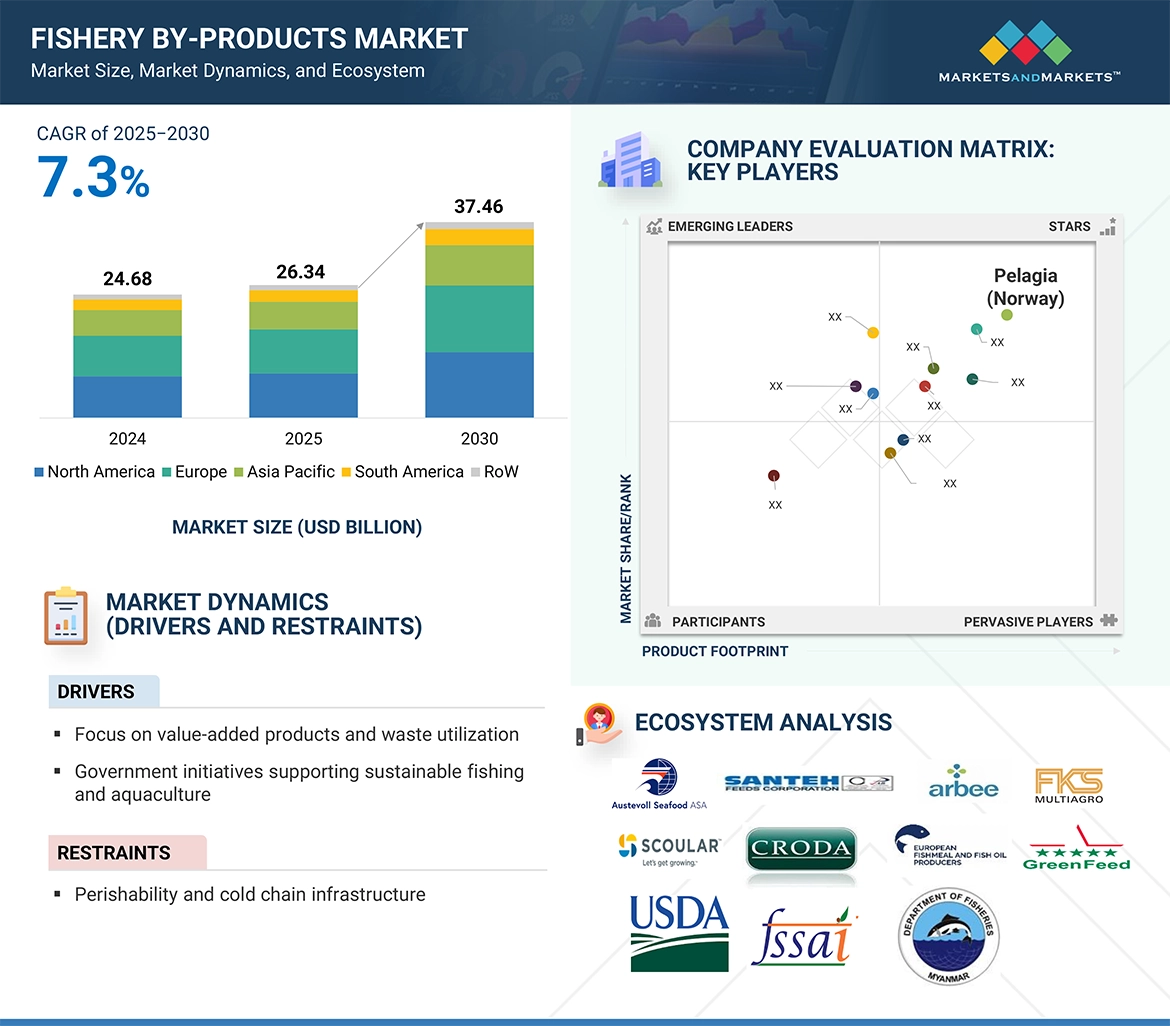The global fishery by-products market is set for significant expansion, projected to grow from USD 26.34 billion in 2025 to USD 37.46 billion by 2030, recording a CAGR of 7.3%. This growth reflects a shifting industry landscape—where sustainability, innovation, and responsible resource utilization are becoming top priorities.
The Sustainability Challenge
Despite this promising growth, sustainability remains a core challenge. Global fish stocks have been declining by around 4% per decade since the 1930s, primarily due to overfishing and climate change. Adding to the strain, fish processing remains energy-intensive, contributing significantly to the industry’s carbon footprint.
Moreover, regulatory frameworks, such as the European Union’s Common Fisheries Policy, now demand traceability and eco-labeling—important for transparency but also increasing compliance costs, particularly in developing nations.
Emerging Opportunities: Innovation for a Blue Future
Even with these challenges, opportunities abound. Enzymatic extraction technologies and recirculating aquaculture systems (RAS) are revolutionizing the way by-products are utilized—enhancing efficiency, yield, and sustainability. Encouragingly, a large majority of consumers—73%—say they are willing to pay more for sustainable products.
To meet the rising demand for fishery by-products and contribute to global food security, the industry must focus on new technologies, circular economy practices, and sustainable sourcing.

Download PDF Brochure: https://www.marketsandmarkets.com/pdfdownloadNew.asp?id=215268677
Fishmeal Leads the Way
By type, fishmeal continues to dominate the fishery by-products market in both volume and revenue. It remains the cornerstone of by-product utilization—used extensively in aquaculture, livestock feed, pet food, and nutraceuticals.
Fishmeal and fish oil are primarily produced from fish waste materials such as heads, bones, viscera, and trimmings. These are processed into high-protein meals and lipid-rich oils, forming the backbone of animal nutrition.
Even as newer products like collagen, gelatin, and chitin/chitosan gain attention, fishmeal retains its relevance due to established processing infrastructure and strong global demand.
A key factor driving fishmeal growth is its integration into aquafeeds, which account for over 60% of global fishmeal usage. Demand remains particularly strong in Asia and Latin America, where aquaculture is rapidly expanding.
Additionally, the pet nutrition segment presents new opportunities—fishmeal is increasingly used in premium, hypoallergenic, high-protein dog and cat foods, valued for its digestibility and omega-rich profile.
Animal Feed: The Largest End-Use Segment
The animal feed industry, especially aquafeed, dominates the end-use segment of the fishery by-products market. Aquaculture—now the fastest-growing sector in global food production—relies heavily on nutrient-rich inputs like fishmeal and fish oil sourced from fishery waste.
Beyond aquaculture, fishery by-products also find their way into poultry, swine, and pet feeds. Although smaller in scale, these applications are gaining momentum thanks to innovations like hydrolyzed fish proteins and fish digest, which enhance palatability and nutrition.
In premium pet food, ingredients such as dehydrated fish protein, fish skin, and fish oil are marketed as omega-rich, hypoallergenic, and skin-boosting—a growing trend in the companion animal care market.
Europe: A Hub for Innovation and Growth
Europe is poised for rapid growth between 2025 and 2030, driven by its strong marine economies and innovation-driven policies. Key countries such as Norway, Denmark, Germany, the Netherlands, Spain, Italy, and Greece are leading the way in converting fish processing residuals—like heads, bones, skins, and shells—into value-added products.
In 2023, non-food exports (including fishmeal and fish oil) represented 21% of total EU fishery export volume and 13% of export value, totaling around USD 1.22 billion.
- Fishmeal exports: 152,600 tons, worth USD 347 million (+5% growth).
- Fish oil exports: 131,000 tons, worth USD 619 million (+28% growth).
These numbers highlight a mature but evolving sector—one transitioning from traditional processing to sustainable, high-value innovations.
Request Sample Pages: https://www.marketsandmarkets.com/requestsampleNew.asp?id=215268677
Key Players Shaping the Market
Leading companies driving innovation and market growth include:
- Pesquera Diamante Peru (Peru)
- Oceana Group Limited (South Africa)
- Scoular Company (US)
- Austevoll Seafood ASA (Norway)
- Maruha Nichiro Corporation (Japan)
- Nippon Suisan Kaisha (Japan)
- Sopropêche (France)
- Thai Union Ingredients (Thailand)
These players are investing in sustainable sourcing, technology integration, and circular economy initiatives to optimize by-product utilization and strengthen the global fishery value chain.

